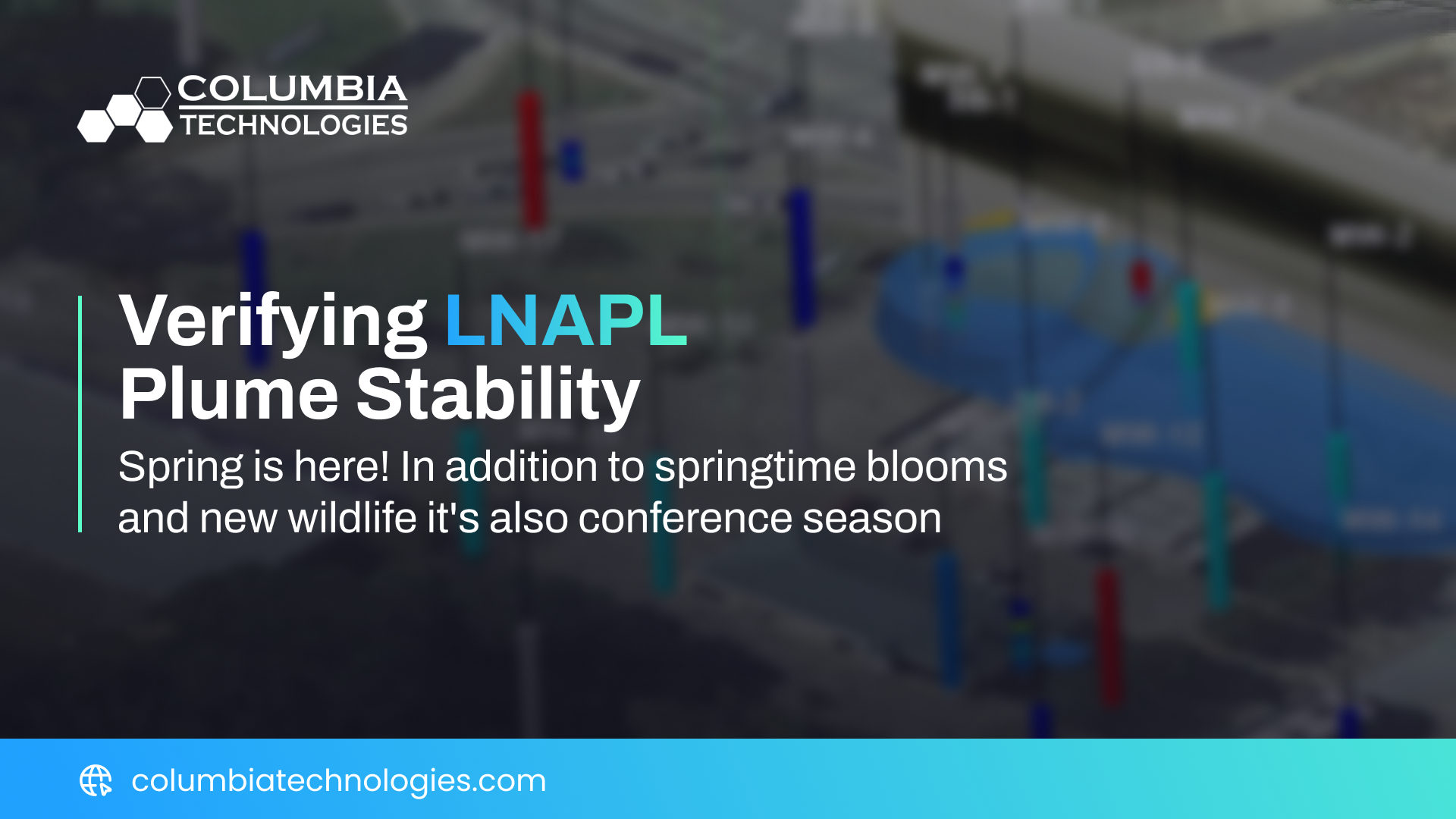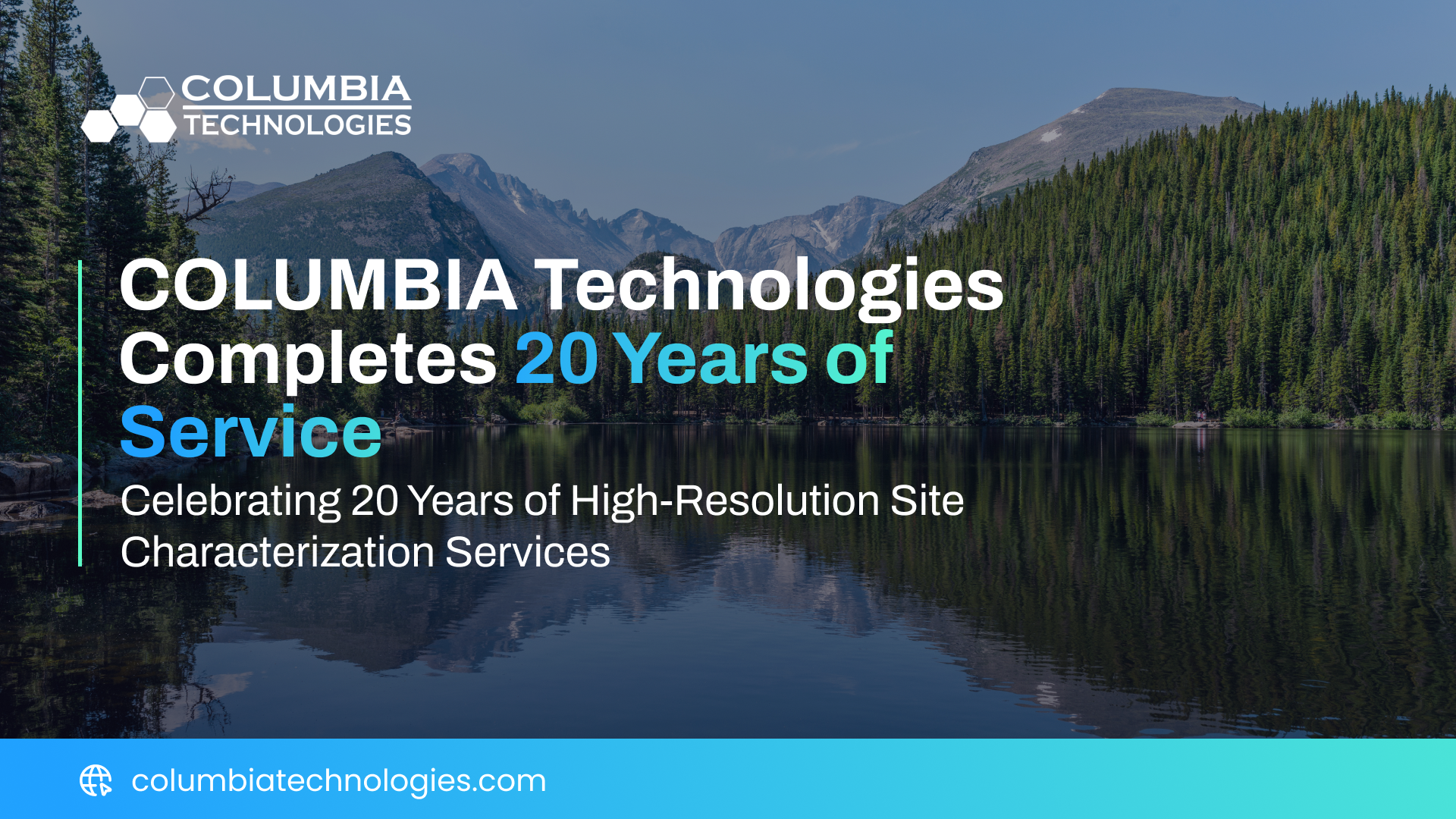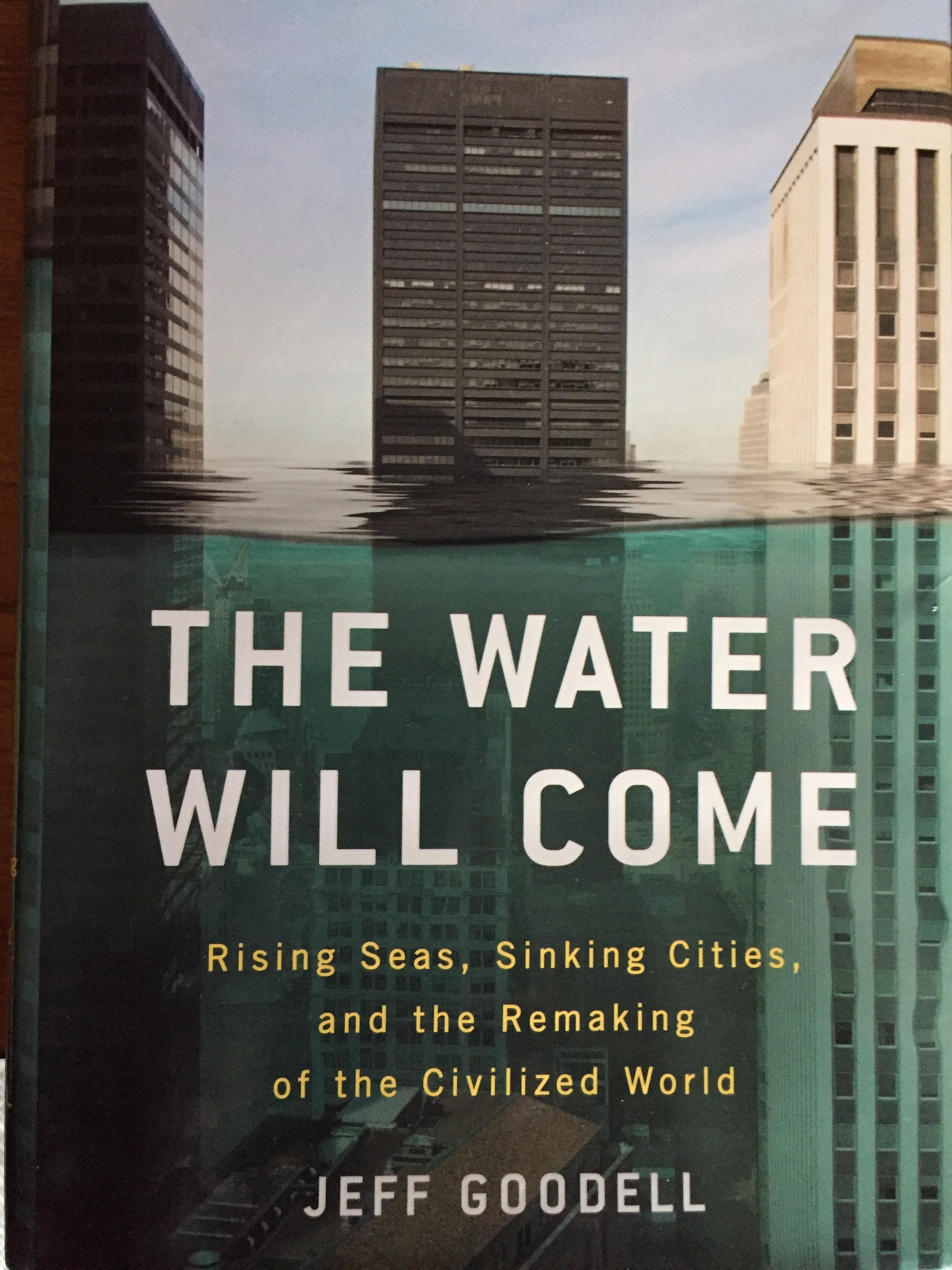Indiana IDEM and IFA Affirm their commitment to improved collaboration.
Indiana IDEM and IFA Affirm their commitment to improved training, communication, and...

Indiana IDEM and IFA Affirm their commitment to improved training, communication, and...

More Services - More Value Added for Our Customers. COLUMBIA Technologies is pleased to announce a...

What an exciting two weeks! Our OPS team just wrapped up our version of "Boot Camp" with three new...

It was my honor and pleasure to participate this morning in the third Kickstarter Program hosted by...

Today is World Environment Day which was first held in 1974. Since then, 143 countries hae taken...

Spring is here! In addition to springtime blooms and new wildlife it's also conference season. It's...

Celebrating 20 Years of High-Resolution Site Characterization Services COLUMBIA Technologies is...

The 26th National Tanks Conference & Exposition (NTC) just wrapped up in Louisville, Kentucky. The...

The 26th National Tanks Conference & Exposition (NTC) will be held September 11-13, 2018, at the...

Climate Change and Sea Level Change. Two controversial topics for some, but well-documented...
Indiana IDEM and IFA Affirm their commitment to improved training, communication, and collaboration.
Many thanks to the Midwestern States Environmental Consulting Association (MSECA) for hosting an annual update by the Indiana Department of Environmental Management (IDEM) and Financing Authority (IFA) this past week. The event was well-planned and attended. In addition to a State of the Agency presentation by Commissioner Brian Rockensuess, we heard updates on Remediation Program Guides and Tips on Submitting Restrictive Covenants. IFA's Brownfields Stakeholder Engagement Coordinator, John Morris, emphasized the importance of early and frequent collaboration on moving impacted real estate through the voluntary cleanup process. Morris also pointed out collaboration can yield better results by thinking outside the box and finding funding solutions creatively.
A common thread running through each presentation was the need for good communication between all the parties involved in the site management process. Early discussions will also identify when differences in understanding and training and decrease the chances of project delays or disapproved applications.
In addition to improving communication, other focus areas identified by Commissioner Rockensuess included improved staffing to help move cases faster, considering how each action of the agency can improve conditions in impacted communities, dealing with the challenges of PFAS contamination and disposal, new legislation, improving the department information management systems, and reducing unacceptable delays in billing.
COLUMBIA Technologies is committed to a safe, efficient, and environmentally sustainable work environment, leveraging emerging technologies and innovation to improve efficiency, enhance safety and capture high-quality data.
For more information or to learn how COLUMBIA Technologies can support your long-term management of environmental liabilities in the Midwest, Click Here.
Tags: Sustainability, IDEM, Brownfields
More Services - More Value Added for Our Customers.
COLUMBIA Technologies is pleased to announce a new partnership with GRUPO DR-1 to provide Unmanned Aerial (Drone) Survey capabilities in Latin America and Africa.
The DR1 GROUP (DR1) is a leading Brazilian drone (UAV) solutions provider with a well-established reputation for safety, quality, efficiency, and innovation. DR1 uses advanced drone and sensor technology, operational excellence, and well-defined safety protocols to deliver high-quality services and products to its clients. Together we innovate to provide high-value information assets that help site managers reduce the risk, uncertainty, and costs of contaminated site cleanup and remediation.
COLUMBIA Technologies is committed to a safe, efficient, and environmentally sustainable work environment, leveraging emerging technologies and innovation to improve efficiency, enhance safety and capture high-quality data. Our collaboration with Grupo DR1 embraces this commitment, leveraging drones to reduce potential safety hazards and improve efficiency and sustainability while delivering higher quality, integrated data to our clients. DR1 is one of only a few companies globally certified as an External Inspection Specialist with drones by the ABS Classifier. In addition, it is the only company in Latin America approved by SHELL to inspect offshore infrastructure.
With national and international clients from the Oil & Gas, Energy, and Mining sectors, Grupo DR1 has extensive experience that encompasses high-resolution photogrammetric surveys, visual and thermographic inspections of natural resources and infrastructure, confined space inspections, and offshore oil spill monitoring.
For more information, Click Here.
What an exciting two weeks!
Our OPS team just wrapped up our version of "Boot Camp" with three new team members. I had the pleasure of observing three really sharp individuals with diverse backgrounds in geology, chemistry, and biology as they participated in two weeks of intense classroom and practical training. Upon successful completion of their training, they will be ready for the busy end-of-year schedule.
Admiral Hyman Rickover, the father of the nuclear navy, and a distant mentor is credited with saying "you can't supervise a lack of knowledge." This guiding principle has been one of the foundations of the COLUMBIA team since its inception. Building on this principle our boot camp emphasizes the principles of operation for all our direct sensing instruments, proper use of standard operating procedures, maintenance, troubleshooting, and accurate field data recording.
The team now adds OSHA health and safety and Red Cross first aid certifications. Then they head to field operations under the watchful eye of our senior geochemist where they each will complete a series of practical factors for each step of site assessment on a variety of sites. The final step in their qualification is a written exam covering a wide range of topics encountered during their training. Upon successful completion of the program, we will be proud to welcome them as fellow employee-owners of COLUMBIA Technologies.
If you are fortunate to have these wonderful folks on your site in the near future please wish them well and provide your own piece of training for them. They are the key to providing the data you can trust!
John
CALL +1-888-344-2704 or
email: info@columbiatechnologies.com
LinkedIn: https://www.linkedin.com/company/columbia-technologies
Tags: COLUMBIA Technologies, News, SmartData Solutions®, Brazil, Africa
It was my honor and pleasure to participate this morning in the third Kickstarter Program hosted by Clemson University. Here are my thoughts for the recent graduates and others participating in today's virtual event.
First, Congratulations! You have demonstrated tremendous drive and persistence to succeed that will carry you far…. whatever your area of expertise or industry.
You enter the industry and the workforce in unprecedented times and will need the drive and persistence that brought you to this point. You are hopefully facing many options and perhaps wondering how to navigate the decisions in front of you.
My advice to you is to FIRST take an inventory of who you are, who you want to work with, and what kind of company or opportunity is the right match for your passion and ideals. Consider these before focusing on your specific technical skills and don’t compromise.
You asked for some golden nuggets so here are my thoughts to consider in your new endeavors:
Tags: COLUMBIA Technologies, News, SmartData Solutions®, Brazil, Africa
Today is World Environment Day which was first held in 1974. Since then, 143 countries hae taken part in recognizing World Environment Day. The day focuses on environmental concerns ranging from pollution to global warming and sustainable food production to protection of wildlife.
The team at COLUMBIA Technologies along with our global partners firmly believe a more sustainable planet requires global collaboration. We are dedicated to providing our clients smarter, scientific-based, sustainable solutions when it comes to contaminated land. It's our goal to be constantly changing the course of remediation to reduce the cost & liability of contaminated land for a better tomorrow.
COLUMBIA Technologies LLC (USA)
COLUMBIA Technologies do Brasil Ltda (Brazil)
COLUMBIA Technologies AFRICA (Pty) Ltd

Tags: COLUMBIA Technologies, High Resolution Site Characterization (HRSC), News, SmartData Solutions®, Brazil, Africa
Spring is here! In addition to springtime blooms and new wildlife it's also conference season. It's always a pleasure to hear industry leaders advancing our our level of understanding of the complex biosphere tainted with man-made contamination. This past month I had the pleasure of attending the Fifth International Symposium on Bioremediation and Sustainable Environmental Technologies close to home in Baltimore 2019. Dr. John Cherry's presentation on what we know compared to what don't know through ignorance was a real eye-opener! The symposium was also highlighted with an awesome panel speaking on Contaminant Geology.
Last week I had the opportunity to speak at the Alabama Conference on USTs on the lessons learned through high-resolution investigations, and in particular the value of high-resolution soil sampling to isolate the residual LNAPL mass on our more complex and difficult sites. Several others emphasized the importance of improved characterization before implementation of expensive and most likely financially unsustainable remediation systems.
ITRC guidance document LNAPL-3: LNAPL Site Management: LCSM Evolution, Decision Process, and Remedial Technologies refers to several lines of evidence to verify LNAPL plume stability. Accurately mapping the residual LNAPL and verifying stability are the first steps in building an effective LNAPL conceptual site model. We were assured by ADEM staff that they hear this message and are supportive of better characterization focused on identifying any residual LNAPL and verifying the LNAPL body is stable.
At COLUMBIA, our team takes pride in providing industry leading data reports to conduct a remedial optimization study to characterize the problem and identify cost saving alternatives through:
Try our Interactive Project Pricing Calculator!
We'll roll up our sleeves and work alongside you better understand those persistent and complex LNAPL sites.
Tags: COLUMBIA Technologies, High Resolution Site Characterization (HRSC), News, SmartData Solutions®, Brazil, ITRC, UST, UST Cleanup Funds, Africa, NTC2018
COLUMBIA Technologies is excited to announce that we just passed our 20 year milestone in providing quality high-resolution site characterization services around the globe.
Working with our partners in Brazil and Africa we have delivered over 2000 individual site characterization projects, providing real data, in real time, reliably to our consulting firm clients.
THANK YOU to our clients, partners, and the many COLUMBIA Technologies team members who made achieving this milestone possible. We look forward to 2019 and beyond to offer a growing range of services to our global customers.
Tags: COLUMBIA Technologies, High Resolution Site Characterization (HRSC), News, SmartData Solutions®, Brazil, Africa
The 26th National Tanks Conference & Exposition (NTC) just wrapped up in Louisville, Kentucky. The conference was professional rewarding as we learned how far the science of LNAPL management has come in recent years. Several presentations highlighted the importance of thorough data gathering before leaping to expensive remedies. Multiple innovative approaches to gather "scale appropriate" data in all types of soil conditions including consolidated bedrock were presented in the technical sessions. Our team had chance to hear from a lot of industry practitioners regarding their current challenges as well as attend the technical sessions. Here are some highlights of what we heard...
WHAT WE HEARD AT NTC 2018
Cho-Yi Risher and Wil Anderson from EPA OUST reported the results of their review of the state of financial responsibility of state funds started in 2017. Some of their observations:
A common theme: "If you have a water contamination problem, you have a soil contamination problem". An LNAPL conceptual site model (LCSM) should address where is the LNAPL, what soil does it reside in, is the LNAPL mass stable, and is it transmissive before implementing more aggressive remedial action.
HRSC or better yet, "scale appropriate" measurements of soil , water, and contaminants are needed for accurate conceptual site model before expending a lot resources on cleanup technologies or approaches. Typically, long-screen monitoring wells with their associated filter packs do not provide sufficient resolution to separate different soil permeabilities and accurately delineate residual contaminant mass.
HRSC is not one tool or methodology but a scientific approach employing scale appropriate measurements of soil (both consolidated and unconsolidated), water, vapor, and contaminants.
The industry and states need flexibility and mechanisms to allow for innovation. Regulations, funding mechanisms, and local procedures should incorporate flexibility to allow new and innovative approaches to be applied on the remaining difficult cases.
Natural Source Zone Depletion (NSZD) can generate mass reduction rates comparable to many engineered remediation methods. Characterization and performance monitoring should include the assessment of NSZD mass degradation rates and be compared to traditional remediation methods.
Tags: High Resolution Site Characterization (HRSC), LNAPL, UST, UST Cleanup Funds, NTC2018
The 26th National Tanks Conference & Exposition (NTC) will be held September 11-13, 2018, at the Galt House Hotel in Louisville, Kentucky. Pre-conference workshops convene on Monday, September 10.
I'm pleased to be presenting a workshop on Focusing High-Resolution Site Characterization (HRSC) for Selecting Remedial Technologies along with Andrew Kirkman of BP, Tom Kady with the EPA ERT, and Queenie Mungin-Davis from EPA Washington. Our goal is for the audience to develop ideas for reducing the cost of cleanup by implementing innovative scale appropriate measurements to improve their LNAPL Conceptual Site Models. We will explore:
For more details download a complete workshop agenda.
Tags: High Resolution Site Characterization (HRSC), LNAPL, UST, UST Cleanup Funds
Climate Change and Sea Level Change.
Two controversial topics for some, but well-documented science. I had an opportunity to read "The Water Will Come" by Jeff Goodell, one of Booklist's Top 10 Science Books of 2017, on an extended plane trip during this holiday season. Goodell presents a well-researched overview of the impact of climate change and the associated changes in sea level on countries, populations, infrastructure, and politics. While the geopolitical challenges of climate change are well beyond the scope of most of our local environmental remediation efforts, Goodell did prompt me to reflect on a few observations we've made in the field and the potential impacts to come.
Is your remediation site in a low lying or coastal area? US EPA confirmed Hurricane Harvey impacted 13 of 41 of the US’s most-toxic waste sites in the Houston area in 2017. Goodell points out that the "Runit Dome, a concrete bunker on Enewetak Atoll where the US military buried 111,000 cubic yards of radioactive debris left behind after then nuclear tests of the Cold War. It sits right at sea level. "It is already cracked, and as the waters rise, it will be submerged, creating a problem of nuclear waste in adjoining waters."
Is the infrastructure that supports your remediation systems or access to your facilities at risk in high-water conditions? The reactor meltdowns at Fukushima, Japan resulted from the failure of the cooling water systems in turn caused by the loss of power sources in extremely high water conditions precipitated by the tsunami and storm surge. Critical infrastructure and no doubt remediation systems failed in New York and New Jersey as a result of Super Storm Sandy.
The Navy base at Norfolk, VA, the largest in the U.S., anticipates a significant impact to operations (and environmental cleanup) by 2020.
How have changes in groundwater levels affected your long-term remediation systems? Even the performance of remedial systems sited a distance from low lying areas are often highly dependent on the accurate placement of system hardware in relationship to groundwater levels. Most readily affected are systems that rely on groundwater control through pumping or multiple phase extraction. Changing storm patterns result in often significant changes in groundwater level potentially with costly impact on the effectiveness of installed remediation systems.
Tags: High Resolution Site Characterization (HRSC), LNAPL, UST, UST Cleanup Funds, Sea Level Change, Climate Change
© COLUMBIA Technologies, LLC. All Rights Reserved.
HQ 1 Research Court Suite 450-402
Rockville, Maryland USA 20850-6252
Tel +1-888-344-2704 |
Email: info@columbiatechnologies.com
Privacy and Legal | Terms of Service